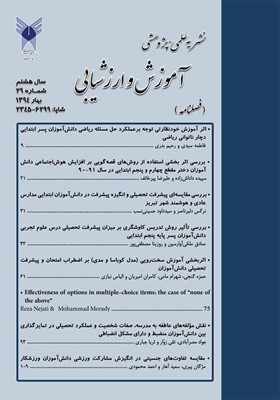بررسی اثر بخشی استفاده از روشهای قصهگویی بر افزایش هوشاجتماعی دانشآموزان دختر مقطع چهارم و پنجم ابتدایی در سال 91-90
محورهای موضوعی : روانشناسی تربیتیسپیده داداشزاده 1 , علیرضا پیرخائفی 2
1 - دانشآموخته کارشناسیارشد گروه برنامهریزی درسی، واحد تبریز، دانشگاه آزاد اسلامی، تبریز،ایران
2 - استادیارگروه کارشناسی ارشد روان شناسی بالینی و عمومی، واحد گرمسار، دانشگاه آزاد اسلامی، گرمسار، ایران
کلید واژه: دانشآموزان, روشهای قصهگویی, هوشاجتماعی,
چکیده مقاله :
پژوهش حاضر به هدف بررسی اثربخشی روشهای قصهگویی بر افزایش هوشاجتماعی دانشآموزان دختر مقطع ابتدایی انجام شد. روش پژوهش حاضر از نوع نیمه آزمایشی و شامل طرح پیش آزمون و پس آزمون با گروه کنترل بود. نمونه پژوهش شامل 60 نفر از دانشآموزان پایه چهارم و پنجم مدارس دخترانه مشکین شهر بود که در سال تحصیلی 91-1390 مشغول به تحصیل بوده و به صورت تصادفی خوشهای انتخاب شدند. سپس آزمودنیها در دو گروه 30 نفری آزمایش و کنترل جای گرفتند. برنامه آموزشی شامل یک دوره 10 جلسهای طی 10 هفته بر روی گروه آزمایش اجرا شد. آزمودنیهای هر دو گروه، پیش و پس از برنامه آموزشی با استفاده از پرسشنامه هوشاجتماعی منطبق با الگوی ترومسو مورد آزمون قرار گرفتند. تحلیل کواریانس تفاوت معنیداری را بین دو گروه آزمایش و گروه کنترل در هوشاجتماعی و مؤلفههای آن نشان داد. نتایج پژوهش نشان میدهد که قصهگویی روش مؤثری در افزایش هوشاجتماعی دانشآموزان بوده و میتواند در محیطهای آموزشی مورد استفاده معلمان قرار گیرد.
The purpose of the current research was to find out the effectiveness of storytelling techniques on enhancing social intelligence of Elementary school female students. The research method was Quasi-experimental with two pre-test and post-test groups. The statistical population included female students of primary school, fourth and fifth grades in Meshkin Shahr in the academic year 1391-1392. The participants included sixty 4th and 5th female students in Meshkin Shahr, in the academic year 1390-1391, who were selected through cluster random sampling. These students were then assigned to two experimental and control groups, each with 30 students. The experimental group received story telling as the treatment for 10 sessions in 10 weeks. The participants in both groups took the pre-and post-test of social intelligence which was based on Iromoso’s model. The covariance analysis showed that there were significant difference between the experimental and control groups in social intelligence and its components. The results showed that storytelling was an effective method to increase the students’ social intelligence and can be used in educational environments by teachers.
منابع
اربابان اصفهانی، مرضیه و قافله کش، مینا. (1385). استفاده از قصه در فرآیند مشاورهای به منظور دستیابی به اهداف تعلیم و تربیت. مقالات برگزیده قصهگویی، نهمین جشنواره قصهگویی کانون پرورش فکری کودکان و نوجوانان.
بازان، تونی. (1384). نیروی نبوغ اجتماعی، ترجمه: حورزاد صـالحی، تهران: انتشـارات پل.
جمالزاده، محمد.(1390). قصهگویی و نمایش خلاق و تأثیر آن بر تربیت کودکان (چاپ اول). شیراز، دانشگاه آزاد اسلامی واحد شیراز.
خانجانی، علی. (1390). هنر قصهگویی(چاپ اول). تهران: کانون چاپ.
خلیلزاده، احد. (1388). بررسی رابطه بین هوشاجتماعی با رضایت شغلی مدیران مستقل شهرستان های چایپاره، پلدشت و چالدران، در سال تحصیلی 89 – 1388.
ظهیری ناو، بیژن. و رجبی، سوران. (1390). بررسی رابطهی کتابخوانی و هوشاجتماعی در دانشآموزان. مجلهی علمی پژوهشی مطالعات ادبیات کودک دانشگاه شیراز، سال دوم،
شمارهی اول، بهار و تابستان 1390، صص: 165-145.
کیـاروچی، جوزف و جوزف پ. فورگـاس و جان د. مایر (1385). هـوش هیجانی در زندگی روزمره، کند و کاوی علمی، ترجمه: جعفر نجفی زند؛ تهران: انتشارات سخن.
گرین، الین.(1378). هنر و فن قصهگویی. مترجم: آدینه پور. تهران: انتشارات ابجد.
موسوی، سیدمختار، حاجی آقالو، عباس، گلشن، پروین و محمدپور، آیتاله.(1382). قصهگویی، قصهخوانی و شعر در مدارس دوره ابتدایی. تهران: وزارت آموزش و پرورش، مؤسسه فرهنگی منادی تربیت، چاپ اول.
همایی، رضا، کجباف، محمدباقر و سیادت، سید علی.(1388). تأثیر قصهگویی بر سازگاریکودکان. مطالعات روان شناختی، دانشکده علوم تربیتی و روانشناسی دانشگاه الزهرا، دوره 5، شماره2،صفحات 133-149.
Desocio J.E. (2005). Accessing Self – Development Thought Narrative Approaches in Child and Adolescent Psychotherapy. Journal of Child Adolesc Psychiatr Nurs, 18(2): 53-61.
Goleman, D. (1998). Emotional Intelligence what It can Matter More than IQ. New York: Banton
Kosmitzki, C., & John, O.P., (1993). The Implicit Use of Explicit Conceptions of Social Intelligence, Personality and Individual Differences, 15, 11-23.
Meijs, N.Cillessen, A. H. N. Scholte, R.H. J. Segers, E., & Spijkerman, R. (2008). Social Intelligence and academic achievement as predictors of adolescent popularity. Behavioural Science Institute, Radboud Universiteit Nijmegen.
Mervis,M,M & Bertrand,F,J.(2003).The emergence of learning – related social skills,Early chigdnood Research Quartely,18,206-224.
Petersen, S., Bull, C., Propst, O., Dettinger, S. and Detwiler, L. (2005), Narrative Therapy to Prevent Illness-Related Stress Disorder. Journal of Counseling & Development, 83, 41–47.
Rahill, S. A. (2002). A comprison or the effectiveness or story-based and skill-based social comptence programs on the development of social problem solving and peer relationship skill of children with emotional disability. Unpublished Doctoral Dissertation, Carlson Albizu University, Maryland [On-Line]. Avaliable: (http:proquest.umi.com/pqdweb).
Salovey, P. & Mayer, J. D. (1990). Emotional Intelligence. Imagination, Cognition and Personality, 9, 185-211.
Miller, P. J., Wiley, A. R., Fung, H., & Liang, C. H. (1997). Personal storytelling asamedium of socialization in Chinese and American families. Child Development; 68 (3):557-68.


